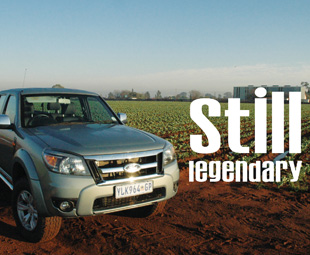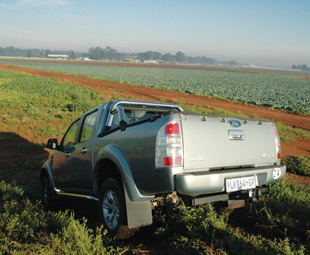Still legendary

When it comes to the name Ranger, “ Built Ford Tough” immediately springs to mind – not to mention expectations of a great driving experience. FOCUS grabs the stylish Ranger 3.0 TDCi XLE 4×4 by the horns to find out for itself…
The Ford Ranger has been a popular sight on South African roads since the nineties, when Ford was the first one-ton pickup to offer class-leading safety features. Ford, of course, boasts the most successful global vehicle line in history, with its F-series pickups. But reputation alone doesn’t cut it; just look at the recent British Petroleum disaster! So, does the latest Ranger make the grade?
A vehicle such as the Ranger can be used in a variety of applications – from farms to highways. Therefore, in order to establish the answer to this question, our Ford Ranger was put to the test over a variety of terrains – from rugged, rural pastures to the potholed paradise of Gauteng.
Our first port of call was a friend’s farm near Heidelberg. Being a hot day, we turned on the air-conditioner (a standard feature, naturally) and popped in a CD before hitting the highway. This Ranger is no rudimentary workhorse – a radio, CD/ MP3 player and iPod connectivity is standard.
The traffic en route to the farm was as lousy as ever, which gave us a good chance to admire the interior of the Ranger. It got the thumbs up immediately – the gauges look good and they are easy to read as well. The instrument panel features red back-lit gauges trimmed in silver, and you can’t miss what they’re telling you – be it night or day.
Our friend’s farm is the ideal testing ground for any bakkie – largely because of what has become known as “Terror Hill”. As its name implies, we have seen many a bakkie shriek in terror at the thought of summiting it.
Not the Ranger. Its 3.0-litre Duratorq TDCi diesel engine has more than enough power and torque to tackle most obstacles – it delivers 115 kW of power at 3 200 r/min and peak torque of 380 Nm at 1 800 r/min. Of course, it is a 4×4 too, and the Ranger is well known for its true off-road ability, which has been proven time and time again on the South African off-road racing circuit. It made mincemeat of “Terror Hill”.
The following day, we decided to take the big trek down to Nampo Harvest Day, an industry festival outside Bothaville, and show off our double cab stud to the farming community. This would be another good test for the Ranger: we would load up five adults, plus lots and lots of luggage. Our cargo included thousands of extremely heavy magazines. Of course, this was no challenge for the Ranger – had it been, we would have hooked up a trailer (it can tow 1.8 t).
The real challenge would be accommodating three adults at the back: as we all know, double cabs are notoriously uncomfortable at the rear (they are only really suited to small kids and midgets), and we had a three-hour drive ahead of us.
 But no one frowned when they climbed in the back, armed with early-morning coffee (easily accommodated in front and back cup holders). And, after a couple of hours on the road, the terrible trio in the back was still quite happy. In fact, Margaret Phillipson, advertising sales executive, commented that the back seat was quite spacious. “Now that’s unusual for vehicles of this type. Plus I like the plush grey leather interior – it is stylish and reminiscent of a luxury car,” she mentioned as Bothaville loomed.
But no one frowned when they climbed in the back, armed with early-morning coffee (easily accommodated in front and back cup holders). And, after a couple of hours on the road, the terrible trio in the back was still quite happy. In fact, Margaret Phillipson, advertising sales executive, commented that the back seat was quite spacious. “Now that’s unusual for vehicles of this type. Plus I like the plush grey leather interior – it is stylish and reminiscent of a luxury car,” she mentioned as Bothaville loomed.
Vic Oliver, FOCUS’ technical correspondent, concurred. “Sure, the front seat is forward but the vehicle is both comfortable and functional. I’m impressed with the leg room here in the rear,” he noted.
Things were even better behind the wheel: the Ranger was proving to be as capable on-road as it had been off. Its five-speed manual transmission was particularly noteworthy: sporty and driver-oriented with a short-throw shifter; as pleasurable for city driving as it was under tough off-road conditions, proving that this vehicle is ideal for someone who wants a bakkie that can be used in a multitude of applications. It was easy to drive too – so much so that I hardly noticed the queue of vehicles at the Nampo gate.
And then we arrived. And parked. And were instantly surrounded by big, burly, beer-boeped admiring farmers (thankfully their admiring glances were aimed at the vehicle and not its occupants). It was clear that the exterior was a huge hit with them – one besotted fan noted that he really liked the sculpted surfaces up front and the vehicle’s modern design. Another moved towards the Ranger’s butt, where he pronounced the latest tail lamp design and newly styled rear step bumper a hit. Yet another agricultural expert pointed out that he was planning to buy one because of its service plan and warranty (at five-years/90 000 km and four-years/120 000 km respectively, both are pretty good).
Then it was off to the show – we left the Ranger confidently, knowing that the alarm and immobiliser should mean that it would still be there on our return.
Returning to Johannesburg, the drive was uneventful – with the exception of a particularly poor road (we had to dodge a few potholes bigger than Bourke’s Luck). The terrible trio in the back didn’t seem to notice though – the suspension did its job and the bakkie never became unbalanced. In fact, the Ranger performed impeccably throughout our gritty, grimy journey, getting us back to Johannesburg safely, smoothly and in quick time.
After driving the Ford Ranger for five short days, we concurred that returning to our “voetstoets” sets of wheels would be a bit of a come-down to say the least. The Ranger had performed so well – be it out on the open road, up and down farm veld, along muddy gravel roads, or in traffic.
The vehicle has clearly been engineered for reliability and performance under any conditions – making it ideal for pretty much anything from commercial applications to family trips. The Ranger might truly be the answer to Henry Ford’s dream: “I will build a car for the great multitude.”
Published by
Focus on Transport
focusmagsa



